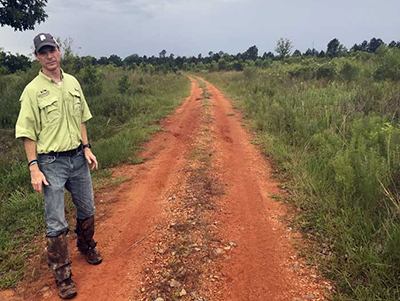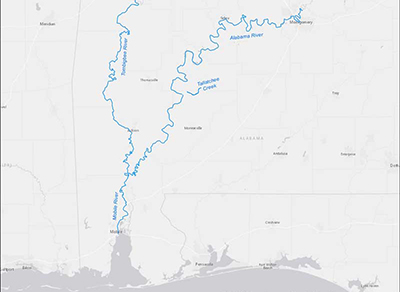
John Wigginton, machete at the ready, chopped his way through the thick understory of privet, sumac and blackberry brambles one recent June afternoon. Logging trucks, bunchers and skidders rumbled in the distance. It had rained heavily; mosquitoes and deer flies accompanied Wigginton on his march through the forest.
“This,” he said upon reaching a sandy overlook populated with well-aged hardwoods, “is Tallatchee Creek. It is a great stream. And we are protecting it in perpetuity. There’s not much more we can do for the channel, except put more species in it.”
Wigginton works for the Westervelt Ecological Services, a division of the Westervelt timber company that owns 400,000 acres across Alabama, including this 3,000-acre pine plantation along Tallatchee. Westervelt, along with the U.S. Fish and Wildlife Service (Service) and the Alabama Department of Conservation and Natural Resources, placed 335 federally threatened orangenacre muckets — mussels — into the creek with hopes of revitalizing a near-extinct species.
So far, the conservation efforts look promising. The Service credits Westervelt, in particular, for its role in conserving at-risk species and habitats. The Tuscaloosa-based company, through its ecological services business, buffers streams, restores creek beds, educates contractors on environmental precautions and runs for-profit mitigation banks to conserve large swaths of land.
“The majority of Alabama is in private ownership so large landowners like Westervelt play an important role in protecting and recovering species,” said Anthony Ford, the Service’s recovery biologist for the orangenacre mucket. “We can’t do it without them.”
Little-known fact: Alabama is the most biologically diverse state east of the Mississippi. With more than 130,000 miles of freshwater streams, plenty of rain and a bounty of different ecosystems (sand dunes, piney woods, tallgrass prairies, cypress swamps, limestone caves) the Yellowhammer State is a biologist’s dream. It’s tops in the country — and, in some cases, the world — for varieties of freshwater fish, mussels, snails and turtles, as well as crayfish. The dam-building craze of the 1960s and 70s, though, reduced the state’s biodiversity. Municipal growth, road construction, industrial and agricultural runoff further harmed creeks and rivers.
The orangenacre suffered too and, in 1993, the Service listed it as threatened. Once plentiful in the Black Warrior, Cahaba and Tombigbee river systems of Alabama and Mississippi, populations of the bivalve mussel with an orange sheen “are fragmented and usually small,” according to the Service.
“Unfortunately,” an aquatic biologist wrote in 2011 “widespread habitat destruction and modification have resulted in very high rates of endangerment (of) mollusks.”
Alabama may be species-rich, but it’s land poor. Public land, that is. Less than 4 percent of the state is owned by cities, counties, the state or the feds with their military bases and national parks and refuges. If the orangenacre was to survive, then streams running through private lands needed to be seeded with juvenile mussels. And timber companies, which own much of Alabama’s private land, needed to be enlisted to ensure access to the water and buffers between streams and woods.
Herbert Westervelt started the Prairie States Paper Corp. in South Bend, Indiana, in 1884. Nearly 20 years later he patented a machine that turned paper into a flat-bottomed, folding grocery bag that opened with a flick of the wrist — the pride of bag boys, including Wigginton, the world over.
The E-Z Opener Bag Co. moved to Tuscaloosa in 1927, opened a pulp-and-paper mill along the Black Warrior River and became Gulf States Paper. Westervelt’s grandson, Jack Warner, assumed the presidency in 1957. He transformed the company into one of the nation’s largest privately held forest-product companies with mills, timberlands and offices in seven states. He also amassed one of the nation’s finest American art collections housed in the Tuscaloosa Museum of Art.
Jack’s son Jon steered the company away from paper production and into timber and land management. He changed the name to the Westervelt Company in 2006. Today, Westervelt is a “land resource organization,” according to its website, with over 500,000 acres and a diverse portfolio of lumber, wood pellet, real estate and hunting preserves. It also established an ecological services business headed in the Southeast by Wigginton.
He grew up in Guntown, Mississippi, near Tupelo, and went on to amass an array of degrees: Lipscomb University (bachelor’s degree in biology); Auburn University (master’s in zoology); the University of Florida (master’s in wetland studies); and, again, Auburn (Ph.D. in forest wetland ecology). Studies behind, Wigginton worked as an ecologist for an engineering consulting firm in Montgomery where he helped develop the state’s first stream mitigation bank. Westervelt, a client, hired him in 2006.
“I like doing good conservation work, but I also love the entrepreneurial part of it,” said Wigginton, 52, while driving the Hybart tract in the company GMC Sierra. “There are a lot of conservation tools in the toolbox. The states do a wonderful job. The federal government does a wonderful job.
“We’re all promoting good conservation and good development projects.”
Hybart, with a defunct grocery and train tracks running among a few, scattered homes, is renowned for two things: the Butterball Invitational turkey hunt; and as U.S. Attorney General Jeff Sessions’ hometown. A “bank” may put Hybart (pronounced “hibbert”) back on the map. Westervelt created a so-called mitigation bank in 2013 to help restore Tallatchee Creek and other wetlands on a 971-acre tract of pine plantation north of the creek. State conservation officials say improving water quality and habitat quality “throughout the basin” is critically important for mussels and other aquatic species.
Mitigation banks work like this: Say a developer wants to build a shopping center in Mobile; its construction will impact wetlands. The developer can proceed, under federal law, if the builder buys mitigation “credits” from a bank, in this case the Alabama River Mitigation Bank managed by Westervelt.
Credits, which run as high as $300,000 nationally offset the destruction of wetlands in one location with the promise of wetlands protection elsewhere. Mitigation bankers are responsible for the wetlands restoration and upkeep via a perpetual conservation easement and trust fund.
“You’ve got to have that public-private link to conserve watersheds, maintain buffers and uphold water quality,” said Paul Johnson, who runs the Alabama Aquatic Biodiversity Center. “But you’ve got to conserve first. You’ve always got time to restore. You don’t always have time to conserve.”

Tallatchee Creek, which flows 2.2 miles west into the Alabama River, area is prime mucket territory. The Southern fatmucket, for example, has long lived in the stream. In all, a half-dozen mussels, including the federally endangered ovate clubshell, reside within the bank’s mitigation zone.
“The stream did not need restoration because it was already in good condition,” said Wigginton, looking down upon the rain-drenched, fast-moving Tallatchee. “That’s why we put the orangenacre muckets here.”
The aquatic center, a branch of the state conservation agency, collected pregnant orangenacres from a nearby creek in 2010. In their laboratory near Tuscaloosa, the mussels’ larvae attached to the gills of redeye bass. The baby muckets fell off the bass within a month and spent the next two years growing to an inch or so in length. The center’s biologists, along with Service counterparts, released 335 orangenacres in Tallatchee Creek in September 2012.
“That sight looks great due to the positive steps taken by (Westervelt),” Johnson said. “The vast majority of the land is still being harvested for timber, but they maintain sufficient buffers which are necessary for a lot of stream animals.” Aquatic center biologists checked the Tallatchee in September 2016 and recaptured five mussels in an hour’s time.
“The reintroduction seems to be working well,” said Jeff Powell, the Service’s assistant supervisor in Alabama. “The animals are surviving and that’s the first big test. We’ve even located gravid (pregnant) females. But we haven’t documented whether they’ve reproduced or not.”
The results aren’t as encouraging elsewhere, said Johnson. No gravid orangenacres have been found anywhere in the Alabama River system.
“We’re at an impasse. The species may be gone,” he said. “This may be the last hurrah in the Alabama basin for the orangenacre mucket.”
The aquatic center is also propagating orangenacres from the Black Warrior River basin and wants to add them to Tallatchee Creek. The center and the Service generally don’t use animals from another basin due to possible genetic differences. More legwork, though, could turn up more pregnant orangenacres in the Alabama River system, they say.
“We always have to exercise caution in situations like this,” Powell added.
The Sierra jounced along logging roads past deer blinds en route to a no-name creek that runs into the Tallatchee. Westervelt logged the plot five years ago and replanted with bottomland hardwoods. It also returned 2,000 feet of the creek to a more natural, meandering state. Willows, tall grasses and button bushes now stand alongside the stream as it wends through overcup oaks and a scattering of other hardwoods.
“It used to cut right through the middle of this bottomland, straight as an arrow,” Wigginton said. “Now we’re restoring riffles, runs, pools and glides. There’s a ton of ecology and engineering in there.”
The restoration work allows Westervelt to sell in-stream and buffer credits to developers. In all, the timber company operates nearly two dozen mitigation and conservation banks nationwide. Another 10 are planned. Doing right by nature, it seems, does well for the bottom line, too.
“If we weren’t making money, our corporate folks would not invest in us,” Wigginton said. “We’re managing the forest in the best possible way we can. And we’re still producing a wood product we all need.”
 Sign In
Sign In
 Sign In
Sign In
